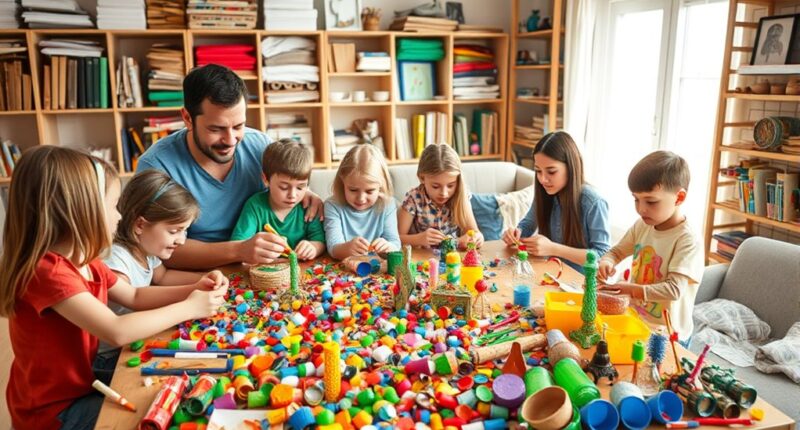Hosting a family art night focused on creative reuse is a fun way to bond while teaching eco-friendly habits. Gather recycled materials like paper, bottles, and buttons, then encourage everyone to craft imaginative projects such as collages, robots, or jewelry. Use questions to spark ideas and emphasize the importance of reusing waste. This activity not only sparks creativity but also raises environmental awareness. Keep exploring to discover more inspiring ways to make eco-art with your family.
Key Takeaways
- Use everyday recyclables like paper, plastic, and cans to create fun, eco-friendly art projects that promote family bonding.
- Incorporate techniques such as painting, gluing, and decorating to inspire imagination and creativity.
- Encourage storytelling and conceptual thinking by asking, “What could this be transformed into?” during craft activities.
- Teach environmental awareness by emphasizing the importance of reusing materials to reduce waste and promote sustainability.
- Explore project ideas like collages, recycled jewelry, and robot sculptures to make family art night engaging and educational.

Family Art Night is a perfect way to bring everyone together and spark creativity in your home. It’s a chance to turn everyday items into something special while teaching kids the value of reusing and recycling. When you focus on recycling crafts, you not only make fun art projects but also help the environment. This approach is perfect for exploring a variety of art project ideas that use materials you’d normally toss away. Think about old newspapers, bottle caps, cardboard boxes, or broken jewelry—these can all be transformed into vibrant, meaningful creations. Kids love the idea of giving new life to things they’d otherwise discard, and you’ll be surprised at how imaginative their ideas become when you encourage recycling crafts.
Family Art Night transforms everyday items into creative, eco-friendly masterpieces while teaching kids the value of recycling and reusing.
To get started, gather a selection of recyclable materials from around your home. Lay out used paper, plastic containers, aluminum foil, fabric scraps, and any other items that can be repurposed. Then, brainstorm some art project ideas that make use of these materials. For example, you could create a collage using magazine clippings and cardboard, or craft a robot out of bottle caps, plastic bottles, and tin cans. Another fun idea is to make jewelry from old buttons and beads, or design a picture frame out of repurposed cardboard and decorated with bottle caps or fabric scraps. The key is to encourage everyone to think outside the box and see potential in what might seem like junk.
During your family art night, guide your children to think about how each item can become part of their artwork. Ask questions like, “What could this be transformed into?” or “How can we turn this into something colorful and fun?” This sparks their creativity and problem-solving skills. Plus, you can incorporate some simple techniques like painting, gluing, and decorating to bring the recycled art project ideas to life. As you work together, you’ll find that the process becomes more about the experience than the finished product—though those can be pretty fantastic, too. Additionally, introducing the concept of anime culture can inspire kids to explore storytelling through their artwork.
Most importantly, emphasize the importance of recycling crafts as a way to help the environment. Show your kids how reusing materials reduces waste and encourages sustainable habits. When you turn recycling crafts into family art projects, you’re not just making art—you’re creating memories, nurturing creativity, and teaching valuable lessons about caring for the planet. So, gather your materials, pick your favorite art project ideas, and enjoy a fun, eco-friendly Family Art Night that everyone will look forward to.
Frequently Asked Questions
What Safety Tips Should I Follow During Art Projects?
To guarantee art safety during projects, always supervise your children closely to prevent accidents. Keep sharp tools, scissors, and hot glue guns out of reach, and teach kids how to handle materials properly. Use non-toxic, child-safe paints and glues, and work in a well-ventilated area. Remind everyone to wash hands afterward. By prioritizing art safety and child supervision, you create a fun, safe environment for creative reuse with recycled materials.
How Can I Involve Very Young Children Safely?
Think of guiding young children through art as tending a gentle garden. You should keep age-appropriate supervision close, like a watchful breeze, ensuring they don’t wander into unsafe territory. Use only non-toxic supplies, the safe seeds that nurture creativity without harm. By creating a secure environment, you let their imaginations bloom, knowing you’re safeguarding their tiny hands and curious minds with steady, caring hands.
What Are Some Budget-Friendly Recycled Material Ideas?
You can find upcycling inspiration in your junk drawer, yard, or thrift store to gather budget craft supplies. Use old cardboard boxes, bottle caps, fabric scraps, and paper rolls for creative projects. These materials are free or inexpensive, making them perfect for a family art night. Reusing items not only saves money but also teaches kids about sustainability while sparking their imagination through hands-on fun.
How Do I Store Completed Projects for Future Enjoyment?
Oh, the joy of endless clutter! To keep your masterpieces pristine, embrace clever storage solutions like labeled bins or flat portfolios. Use preservation techniques such as acid-free paper or spray sealants to protect your art from fading. Store projects in a cool, dry place, away from sunlight. Your future self will thank you for these simple steps—because nothing says “treasured” like finding that perfect piece years later!
Can This Activity Be Adapted for Large Groups or Classrooms?
Yes, you can adapt this activity for large groups or classrooms by dividing participants into smaller groups. Assign each group a specific project or recycled materials, and set up multiple stations to keep everyone engaged. This approach enhances teamwork, guarantees each child gets hands-on experience, and maintains a manageable group size. With proper planning, classroom adaptation becomes simple, fun, and educational for all ages.
Conclusion
As you wrap up your family art night, remember that every creative effort is a gentle reminder of the magic in simple acts. By repurposing recycled materials, you’re not only crafting unique masterpieces but also nurturing a shared sense of wonder and responsibility. Embrace the quiet joy of these moments, knowing that your small acts of creativity help inspire a more sustainable future. Keep exploring, creating, and cherishing these precious, understated memories together.








